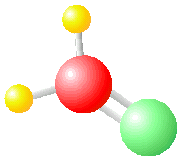Fact Sheet: Formaldehyde
 Formaldehyde is a colorless gas compound (HCHO) that can irritate eyes, mucous membranes and the upper respiratory system.
Formaldehyde is a colorless gas compound (HCHO) that can irritate eyes, mucous membranes and the upper respiratory system.
Q: What is formaldehyde?
A: It is a chemical that is released into the air as a pungent gas. It has a number of useful properties: It's a good preservative and makes an excellent adhesive. Therefore, it is used widely in the building and furnishings industries. It is also found in small amounts in some textiles as an anti-wrinkle agent.
Q: Why should I be concerned about formaldehyde?
A: It is a strong irritant that causes watery eyes and in low doses, causes burning sensations in the eyes, nose, and throat. Wheezing and coughing, fatigue, skin rashes, headaches, loss of coordination and nausea are other symptoms. Larger doses can cause asthma attacks as well as damage to the liver, kidneys and the central nervous system. Some people are highly sensitive and react to formaldehyde concentrations that don't bother most people. Formaldehyde has been shown to cause cancer in laboratory animals, but there is limited evidence that it causes cancer in humans.
Q: What are the major sources of formaldehyde?
A: Particleboard is a major contributor of formaldehyde to the home environment. The culprit is the adhesive, urea formaldehyde, which can break down releasing the formaldehyde. Phenol formaldehyde (used in exterior panels) does not present problems. Some particleboard is now manufactured with reduced formaldehyde. Other sources include interior plywood, veneered or laminated furniture and cabinets, some professionally applied furniture and floor finishes, paneling, permanent press fabrics (some drapes), combustion products and cosmetics.
Q: How can I detect whether my home has significant concentrations of formaldehyde?
A: You may be able to detect it by its odor. Also, environmental testing firms, listed in the yellow pages of the phone directory, should be able to test for formaldehyde levels. Since such tests are costly, you should learn whether your home has possible sources of formaldehyde. Also, do-it-yourself test kits are available, but there is some question about their accuracy.
Q: What can I do to reduce formaldehyde problems?
A: Formaldehyde cannot penetrate plastic laminate and is at least partly blocked by coatings. Varnishes and special formaldehyde sealants are also available. Apply these coatings to all exposed edges and surfaces, such as the undersides of countertops, cabinet interiors and drawers. High humidity and elevated temperatures cause formaldehyde release, so you might want to control humidity through air conditioning and dehumidifiers. Also, increase ventilation, particularly after bringing new sources of formaldehyde into the home. When remodeling and in new construction, select low formaldehyde materials.
